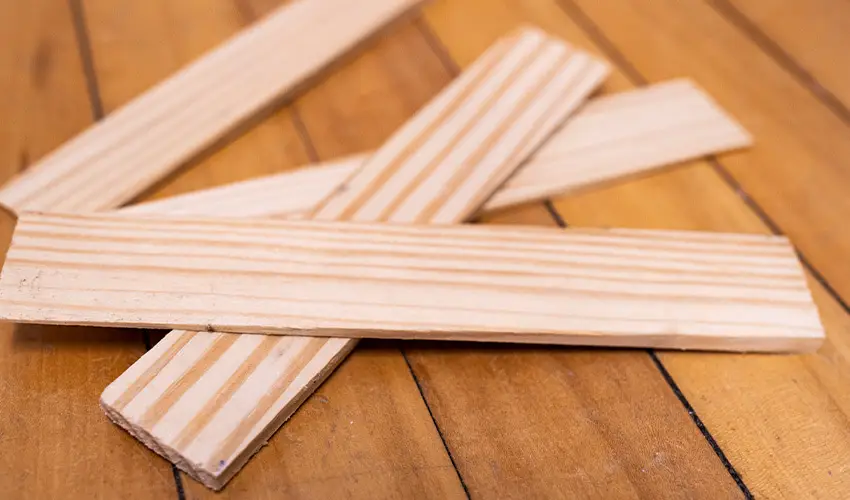What is a Shim? A Guide to Using Shims Effectively

Plain and simple, a shim is a tapered wedge used for making slight adjustments to home elements, such as door frames and windows, to make them plumb (perfectly vertical) and level. A shim will fill the space between two surfaces and ensure that they are connected.
Wedging a shim between a frame and the adjacent stud helps to incrementally bring the element plumb and level. Not limited to just windows and doors, shims can be used to square up cabinets, level a wobbly toilet, adjust subfloors and floorboards, or eliminate creaks in outdoor decking.
You may have come across a few of these thinly sliced wedges among the tools in your garage. While they may appear to be scraps from past projects, shims are an important element for a variety of DIY fixes and fittings.
Keep reading to learn more about how to use a shim from the home repair and maintenance experts at Mr. Handyman.
Types of Shims
Since they are used in many different ways, there are many types of shims. The most common include the following:
- Horseshoe shims
- Construction shims
- Stackable shims
- U-shaped shims
- Wedge shims
- Flat plate shims
- Keyslot shims
Wood is the most common material for a shim. They are often cut from cedar or pine and well-suited for almost any interior adjustment. Plastic shims are another popular choice, given that they are water and rot-resistant, making them ideal for plumbing or exterior adjustments.
How to Choose the Right Shim
The first step in choosing the right shim is understanding what you’re using it for. The shim you choose for trim work will differ from the one you use for a bathtub installation.
Next, consider the pressure the shim will be under. If you’re using it for things like stone countertops, bathtubs, or other heavy objects, the fibers of a wooden shim may break down over time. In this case, a plastic or metal shim would be the better choice.
However, plastic shims are more expensive and harder to shape than wooden shims. If you’re using your shim for trim work, doors, or windows, consider using a wooden one. This way, you can shape your shim to fill the exact space you need it to fill. Be sure to take proper measurements of the fill area so you purchase the correct size shim(s).
How to Install Shims
Despite the best measurements and care, once a door or window is put into place, it’s unlikely to be perfectly square. This is especially true when dealing with an older home. Rather than agonizing over cutting a new frame or trying to nail in an absolutely precise opening, shims are used to make the final tweaks, so everything fits perfectly.
Once a door or window is seated into the opening, place shims in any gaps between the window or door casing and the framed opening. Use a hammer or mallet to gently tap the shim into place and use a level to check that the window or door is moving toward plumb or level as desired.
If one shim is not thick enough for the required adjustment, tap another shim in right next to the first one, but face it the opposite way. Be careful not to drive the shim in too far, as they are difficult to pull back out.
Once the door or window is plumb and level, drive a nail or screw from the casing, directly through the shims and into the framing to secure it. Once the window or door is firmly seated and nailed, use a utility knife to score the excess shim length and break it off.
Advantages of Using Shims
Shims are imperative when it comes to adjusting the final fittings of windows, doors, cabinets, and more.
Wooden shims are a great way to bridge the gaps when installing trim, doors, windows, or cabinetry projects. They also help to level floors, tables, or chairs. Plastic shims work great for toilets, bathrooms, subfloors, or exterior elements.
A well-placed shim can pull a canted (misaligned) door frame to plumb and level as it should be. It’s also a fairly easy DIY task. Tapping in a shim is far less daunting than installing a new window or toilet.
Common Mistakes to Avoid When Using Shims
While installing a shim is a fairly easy project, there are some mistakes to watch out for. First, make sure that you’re pushing it in just far enough. It needs to be placed in the correct position to do its job. The shim should be held firmly in place by the weight of the object. If it’s loose and moves during the final installation, it could make whatever you’re trying to plumb uneven or misaligned.
Second, choose the proper material. If you’re installing a shim that may be exposed to water often or supporting something heavy, don’t use a wooden shim. Instead, use a plastic one, which will hold up better over time.
Third, always be sure to secure your shim. Unsecured shims can slip or drop from their position, putting your materials at risk.
Alternative Uses for Shims
What are shims used for? There are many different reasons and uses for a shim, including a variety of Mr. Handyman’s services! A short list includes the following:
- Leveling windows
- Leveling plumbing
- Leveling kitchen cabinets
- Eliminating floorboard squeaking
- Adjusting deck boards
- Flatten flooring
- Leveling doors
Shims are so popular because they are so versatile!
Need Help With Your Project?
Now that you know what a shim is and how to use one, you’re ready for your next DIY project! While using a shim is less daunting than installing a whole new door, you may not have the time, energy, or desire to do it yourself.
That’s where your local Mr. Handyman can help. Give us a call to learn more about our homeowner and commercial services or to find your local Mr. Handyman.
Our friendly customer service team will be happy to schedule an appointment for one of our qualified service professionals to come out and give you an estimate for your home project. One of the best parts about hiring Mr. Handyman is our Done Right Promise™! We promise that every job will be done to your satisfaction!
Leave the installation to the pros! Call Mr. Handyman or request an appointment online for a guaranteed professional service and the perfect fit for your home service needs.
 Click to call
Click to call


